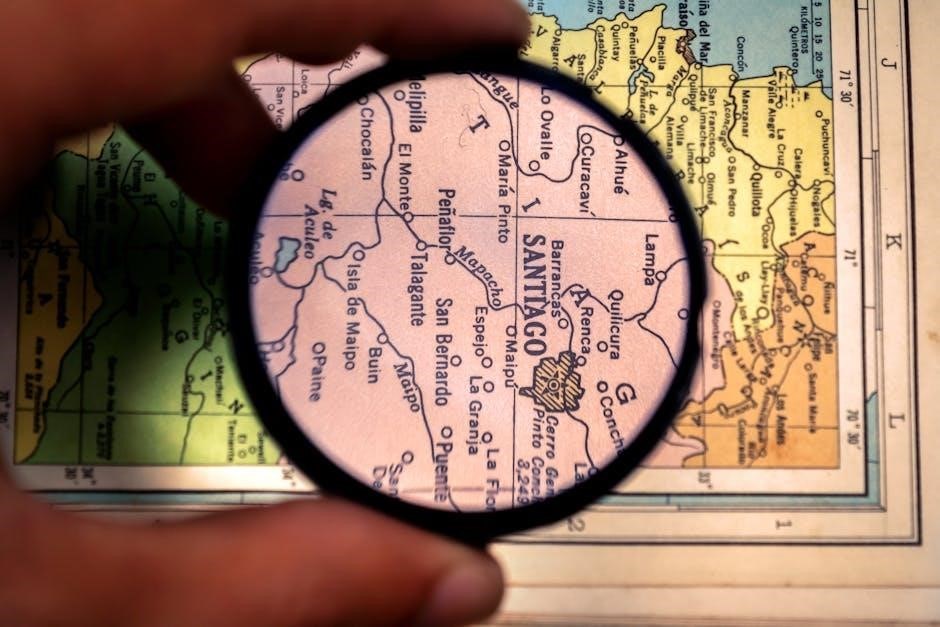Lash mapping guides are essential tools for creating personalized eyelash extension designs, ensuring each lash complements the client’s natural features and desired aesthetic.
What is Lash Mapping?
Lash mapping is a strategic process used by lash artists to plan the placement of eyelash extensions. It involves analyzing the natural lash line and determining the best lengths, curls, and thicknesses for each section of the eye. This technique ensures a personalized and balanced look, enhancing the client’s natural features while achieving their desired aesthetic. By creating a detailed map, artists can tailor the extensions to suit individual eye shapes, preferences, and lifestyles, resulting in a seamless and flattering finish.
Importance of Lash Mapping in Eyelash Extensions
Lash mapping is crucial for achieving a natural, balanced, and customized eyelash extension application. It ensures extensions are placed strategically to enhance the client’s eye shape and personal style. Proper mapping prevents lashes from looking uneven or causing damage to natural lashes. By tailoring the length, curl, and thickness of extensions to each section of the eye, lash mapping creates a seamless and polished finish, boosting both aesthetics and client satisfaction. It is a foundational step that elevates the quality and longevity of the lash application.

Understanding the Tools and Materials Needed
Essential Tools for Lash Mapping
Key tools include gel pads for marking, rulers for precise measurements, and reference guides to ensure accurate lash placement and customization for various eye shapes.
The right tools are crucial for effective lash mapping. Gel pads or marking strips are used to outline the lash line, while rulers or calipers ensure precise measurements. Tweezers aid in isolating natural lashes, and lash mapping charts provide visual guides for placement. Reference guides or apps can help determine the best lash lengths and curls for different eye shapes. These tools collectively enable lash artists to create a customized, symmetrical lash map, ensuring a flawless application tailored to the client’s features and preferences.
Materials Required for Creating a Lash Map
Creating a lash map requires specific materials to ensure accuracy and precision. A lash mapping chart or grid is essential for visual planning. Gel pads or eye shields protect the lower lashes during application. A ruler or caliper measures the eyelid’s length, while markers or pencils outline the lash line. Tweezers help isolate natural lashes, and reference guides or apps aid in selecting appropriate lash lengths and curls. These materials work together to help artists design a personalized lash map that enhances the client’s natural beauty and desired style.

Step-by-Step Guide to Creating a Lash Map
Begin with a pre-mapping consultation to understand the client’s preferences. Measure and mark the eyelid to determine lash placement. Apply extensions precisely following the map.
Pre-Mapping Consultation with the Client
A pre-mapping consultation involves discussing the client’s preferences, lifestyle, and eye shape. This step ensures the lash design aligns with their expectations and natural features. Artists analyze the client’s lashes to determine suitable lengths, curls, and thicknesses. Communication is key to understanding desires, whether natural or dramatic. This consultation sets the foundation for a personalized lash map, enhancing the final result’s satisfaction and aesthetic appeal.
Measuring and Marking the Eyelid
Measuring and marking the eyelid is a critical step in lash mapping, ensuring precision and symmetry. Artists use specialized tools to divide the eye into sections, determining where extensions will be applied. Gel pads or markers are often used to outline the lash line, creating a clear guide for placement. This process helps tailor the design to the client’s eye shape and natural lash distribution, ensuring a balanced and natural-looking result. Accurate measurements and markings are essential for achieving a flawless, personalized lash application.
Applying Extensions Based on the Map
Applying extensions based on the map ensures a tailored, precise lash design. Using the pre-drawn guide, artists strategically place lashes according to the marked sections. Gel pads or lash strips are often referenced to maintain symmetry. Each extension is carefully attached to natural lashes, following the mapped lengths, curls, and thicknesses. This method allows for customization, enhancing the client’s natural features while achieving their desired aesthetic; The map serves as a blueprint, guiding the application to create a balanced, polished look that complements the eye shape and personal style.

Lash Mapping Techniques for Different Eye Shapes
Customizing techniques for almond, round, and hooded eyes ensures flattering results. Each shape requires tailored strategies to enhance natural beauty and achieve desired aesthetics.
Lash Mapping for Almond-Shaped Eyes
Almond-shaped eyes are characterized by visible whites below the iris. Lash mapping for this shape focuses on enhancing their natural elegance by strategically placing longer lashes towards the outer corners to create a balanced, cat-eye effect. Using varying lengths and curls can add depth and dimension. It’s important to maintain symmetry and avoid overwhelming the eye with too much volume. This technique ensures a seamless, polished look that complements the eye’s natural allure while maintaining comfort and a natural appearance.
Lash Mapping for Round Eyes
Lash mapping for round eyes aims to create the illusion of length while maintaining a youthful, innocent appearance. These eyes typically have minimal visible whites below the iris. To enhance their shape, focus on placing slightly longer lashes toward the center and inner corners to draw the eye outward, creating an elongated effect. Avoid heavy volume on the outer corners, as this can make the eyes appear smaller. Instead, use lighter volume and varying curls to add depth without overwhelming the natural features, ensuring a balanced and flattering look that complements the eye’s natural contours.
Lash Mapping for Hooded Eyes
Lash mapping for hooded eyes requires careful consideration due to the limited visible eyelid space. To enhance this eye shape, focus on applying shorter to medium-length lashes along the natural lash line, avoiding excessive volume at the outer corners, which can make the eyes appear smaller. Place slightly longer lashes in the center to create depth and dimension. Use lighter volume and softer curls to avoid overwhelming the delicate features. This technique ensures lashes complement the eye’s natural structure without appearing too heavy or cluttered, creating a balanced and elegant look tailored to hooded eyes.

Common Mistakes to Avoid in Lash Mapping
Overlooking the natural lash line and incorrect measurements are common errors. These mistakes can lead to uneven or unflattering lash placements, emphasizing the need for precision and customization.
Overlooking the Natural Lash Line
One of the most critical mistakes in lash mapping is ignoring the natural lash line. Failing to consider the client’s natural lash growth pattern can result in extensions that look uneven or unnatural. The lash line serves as the foundation for the mapping process, ensuring extensions are applied in harmony with the client’s eye shape and lash distribution. Neglecting this step can lead to poor adhesion and an unbalanced appearance. Always analyze the natural lash line before creating the map to achieve a seamless, customized look that enhances the client’s features. Proper alignment is key to a flawless result.
Incorrect Measurements and Placement
Incorrect measurements and placement are common pitfalls in lash mapping that can lead to uneven, unnatural-looking extensions. Mismeasuring the eye or lash line can result in lashes that are too long or short for specific areas, disrupting the desired aesthetic. Improper placement may cause lashes to cluster or look out of alignment, potentially damaging natural lashes. To avoid this, use precise tools and reference guides to ensure accurate measurements. Tailoring the map to the client’s eye shape and lash distribution is crucial for a balanced, professional finish. Attention to detail is key to achieving flawless results.

Advanced Tips and Tricks for Mastering Lash Mapping
Mastering lash mapping requires precision and creativity. Use reference guides to enhance accuracy, customize designs based on eye shapes, and ensure symmetry for a flawless look.
Using Reference Guides for Precision
Reference guides are invaluable for achieving precision in lash mapping. They provide standardized measurements and visual aids to ensure symmetry and balance. By using these tools, lash artists can accurately determine lash placement, length, and curl alignment. Guides often include templates for various eye shapes, helping to customize designs effectively. They also assist in maintaining consistency, especially for beginners. Incorporating reference guides into your workflow enhances the accuracy of lash application, ensuring a natural and polished finish tailored to each client’s unique features.
Customizing the Map for Individual Preferences
Customizing the lash map is crucial for meeting individual preferences and enhancing the client’s natural beauty. Lash artists consider the client’s eye shape, personal style, and lifestyle to tailor the design. For example, a client with almond-shaped eyes may prefer longer lashes at the outer corners for a dramatic look, while someone with hooded eyes might opt for shorter lashes for a subtler appearance. By adjusting lash length, curl, and thickness, the map is personalized to achieve the desired aesthetic, ensuring the final result aligns with the client’s vision and expectations.

Case Studies and Examples
Real-life examples highlight successful lash mapping techniques, showcasing how customized designs enhance natural beauty. Clients with almond-shaped eyes achieved dramatic results, while round eyes benefited from balanced lash placement.
Real-Life Examples of Successful Lash Mapping
Successful lash mapping examples demonstrate how tailored designs enhance natural beauty. For instance, a client with hooded eyes achieved a voluminous yet natural look by mapping shorter lashes at the inner corners and longer ones toward the outer edges. Another case involved a client with sparse natural lashes, where a detailed map ensured even distribution of extensions for a fuller appearance. These examples highlight how precise mapping solves challenges and achieves desired aesthetics, proving its importance in lash artistry. Tools like gel pads and reference guides aid in creating these personalized looks.
Future Trends in Lash Mapping
Future trends include innovative techniques, AI integration, and advanced tools for precision. Emerging technologies will enhance customization, offering more natural and personalized lash extension results for clients.
Emerging Techniques and Technologies
Emerging techniques in lash mapping include AI-powered tools for precise measurements and augmented reality for visualizing results. Digital mapping software enables artists to pre-design lash looks, enhancing customization. Advances in materials, like biodegradable lashes, are gaining traction. Additionally, 3D printing technology is being explored for creating custom lash clusters, offering unparalleled personalization. These innovations aim to streamline the process, improve accuracy, and cater to diverse client preferences, setting new standards in the lash industry.
Lash mapping guides are indispensable for achieving stunning, personalized eyelash extension results. By understanding eye shapes, using the right tools, and mastering techniques, artists can enhance natural beauty. Avoiding common mistakes ensures precision and client satisfaction. Advanced tips and emerging technologies, like AI and AR, are revolutionizing the craft. Whether for beginners or pros, lash mapping remains a cornerstone of exceptional lash artistry, helping create bespoke looks that delight clients and elevate the industry’s standards.
